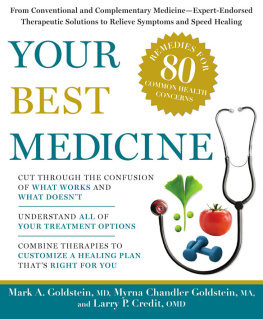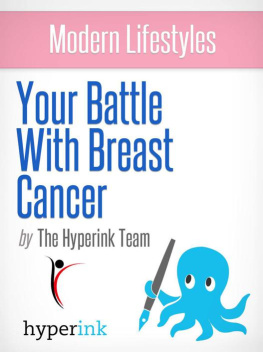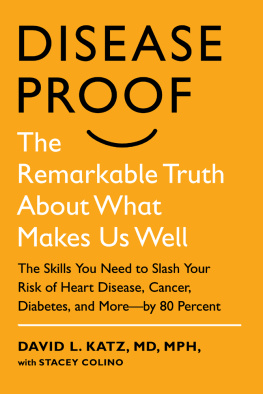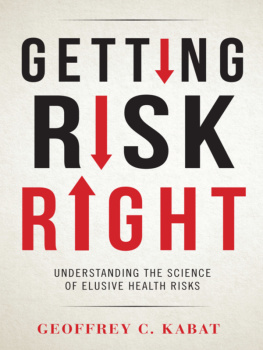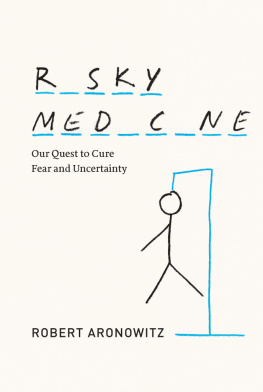RISK, CHANCE, AND CAUSATION
Risk, Chance, and Causation
Investigating the Origins and
Treatment of Disease
MICHAEL B. BRACKEN
Yale
UNIVERSITY PRESS
NEW HAVEN AND LONDON
Published with assistance from the foundation established in memory of
Philip Hamilton McMillan of the Class of 1894, Yale College.
Copyright 2013 Michael B. Bracken.
All rights reserved.
This book may not be reproduced, in whole or in part, including illustrations, in any form (beyond that copying permitted by Sections 107 and 108 of the U.S. Copyright Law and except by reviewers for the public press), without written permission from the publishers.
Yale University Press books may be purchased in quantity for educational, business, or promotional use. For information, please e-mail sales.press@yale.edu (U.S. office) or sales@yaleup.co.uk (U.K. office).
Set in Electra type by Newgen North America.
Printed in the United States of America.
Library of Congress Cataloging-in-Publication Data
Bracken, Michael B., 1942
Risk, chance, and causation : investigating the origins and treatment
of disease / Michael B. Bracken.
p. ; cm.
Includes bibliographical references and index.
ISBN 978-0-300-18884-4 (cloth : alk. paper)
I. Title.
[DNLM: 1. Diseaseetiology. 2. Risk Factors. 3. Therapeutics, QZ 40]
616.071dc23
2012045173
A catalogue record for this book is available from the British Library.
This paper meets the requirements of ANSI/NISO Z39.48-1992
(Permanence of Paper).
10 9 8 7 6 5 4 3 2 1
To
Kai, Lucian, Liln, and Finn
I am not so sanguine as to believe that when you are able
to read this book, its lessons will have been learned:
plus a change, plus cest la mme chose.
CONTENTS
ONE
Risk, Chance, and Causation: Investigating the Origins and Treatment of Disease
TWO
Chance and Randomness
THREE
Risk
FOUR
Randomization and Clinical Trials
FIVE
More Trials and Some Tribulations
SIX
Harm
SEVEN
Screening, Diagnosis, and Prognosis
EIGHT
A Statistical Sojourn
NINE
Disease Clusters
TEN
Genetics and the Genome
ELEVEN
The Study of Mankind Is Man: Reflections on Animal Research
TWELVE
Celebrity Trumps Science
THIRTEEN
Replication and Pooling
FOURTEEN
Bias in Publication and Reporting
FIFTEEN
Causes
SIXTEEN
Ultimate Causation
ACKNOWLEDGMENTS
Many people over a lifetime of work have helped form the ideas and concepts explored in this book. They are far too many to name, but I hope they will recognize their contributions and forgive me for not mentioning them individually. For the book itself, I am grateful to Yale University for the sabbatical that allowed me to complete the project and to the Fellows of Green Templeton College at Oxford University for providing an academic home away from home for many years. Lia Kidd has kept my professional life in good order for more years than we both care to remember, and she solved numerous technical problems during the production of the manuscript and proofread the entire book more than once. Others at the Yale Center for Perinatal, Pediatric, and Environmental Epidemiology assisted in obtaining copyrights and TIFFs and greatly helped in the books production: thank you Geetanjoli Banerjee, Susan Chase Jones, Jodi OSullivan and Matt Wilcox. At Yale University Press, Sara Hoover and Jean Thomson Black, my editor, have been supportive throughout the project. I especially appreciate the thoughtful and sensitive approach to copy editing by Eliza Childs. Iain Chalmers is a lifetime supporter and collaborator, and I am grateful to him for reading the chapter that relates to his work. Andrew De-Wan, Ted Holford, and Jessica Illuzzi are all valued colleagues, and they made helpful comments on chapters in their specialties. Students in my Evidence-Based Medicine and Health Care course at Yale have never failed to provide critical feedback, and their reading of various chapters is equally appreciated. Emmanuelle Delmas-Glass was the perfect foil for me to bounce ideas off as she has all the qualities of the books intended audiencebright people without any particular professional interest in the topic. My wife Maryann, as always, rose to the challenge and was a keen editor and enthusiastic supporter of this work. Of course, any errors and all the strong opinions are entirely my own.
ABBREVIATIONS
g | Microgram |
A | Adenine |
ACS | American Cancer Society |
AD | Alzheimers disease |
AIDS | Acquired immune deficiency syndrome |
AMD | Adult macular degeneration |
ARRIVE | Animal research: reporting in vivo experiments |
ASD | Autism spectrum disorder |
BBC | British Broadcasting Corporation |
BCE | Before the Common Era |
BCS | Breast conserving surgery |
BID | Bis in die (twice a day) |
BL-4 | Biosafety Level 4 (facility) |
BP | British Petroleum |
BPA | Bisphenol-A |
BPD | Bronchopulmonary dysplasia |
BSE | Breast self-examination |
C | Cytosine |
CA-125 | Cancer antigen 125 |
CAST | Chinese Acute Stroke Trial |
CDC | Centers for Disease Control and Prevention |
CE | Common Era |
CI | Confidence interval |
CNS | Central nervous system |
CNV | Copy number variation |
CRASH | Corticosteroid Randomization after Severe Head (injury) |
DDT | Dichlorodiphenyltrichloroethane |
DES | Diethylstilbestrol |
DNA | Deoxyribonucleic acid |
E | Expected number of events |
EMF | Electromagnetic fields |
EPA | Environmental Protection Agency |
F | Fahrenheit |
FDA | Food and Drug Administration |
G | Guanine |
g | Gram |
GI | Gastrointestinal |
GPS | Global Positioning System |
GWAS | Genome-wide association studies |
HIV | Human immunodeficiency virus |
HMS | Her Majestys Ship |
HPV | Human papilloma virus |
HRT | Hormone replacement therapy |
HuGENet | Human Genome Epidemiology Network |
HupA | Huperzine A |
IARC | International Agency for Research on Cancer |
IOM | Institute of Medicine |
IPDMA | Individual patient data meta-analysis |
IQ | Intelligence quotient |
IRBs | Institutional Review Boards |
Next page

